


Henry Ford introduced a different market model by focusing on the social aspect of a business's productivity, offering increased wages to workers. This encouraged them to buy the cars they helped produce (most of which were financed directly by the Ford Company). This approach demonstrated that shifting the dynamics between a seller and a buyer can result in better outcomes for both supply and demand.
Cloudfunding introduces a new market that prioritizes this social aspect by removing the traditional incumbent trader in the middle. Instead, a decentralized market maker network is placed, directly monetizing the inventories sellers want to sell, thus closing the arbitrage window for incumbents.
This new market architecture is set in local economies around the world, allowing local sellers to list their inventory at full selling prices. The decentralized market makers then monetize this inventory before it is released to buyers that sellers wish to attract. As inventory is released, buyers have the opportunity to purchase at descending prices that cascade down to 20% of the full selling prices without affecting the seller's guaranteed full selling prices. There are no fees for sellers to list and sell, and no fees for buyers.
The DeCom Markets provide real-time activity of productivity that occurs in all local economies within the real economy. This is where market makers and global users can analyze and set strategies to gain from various activities in the market.
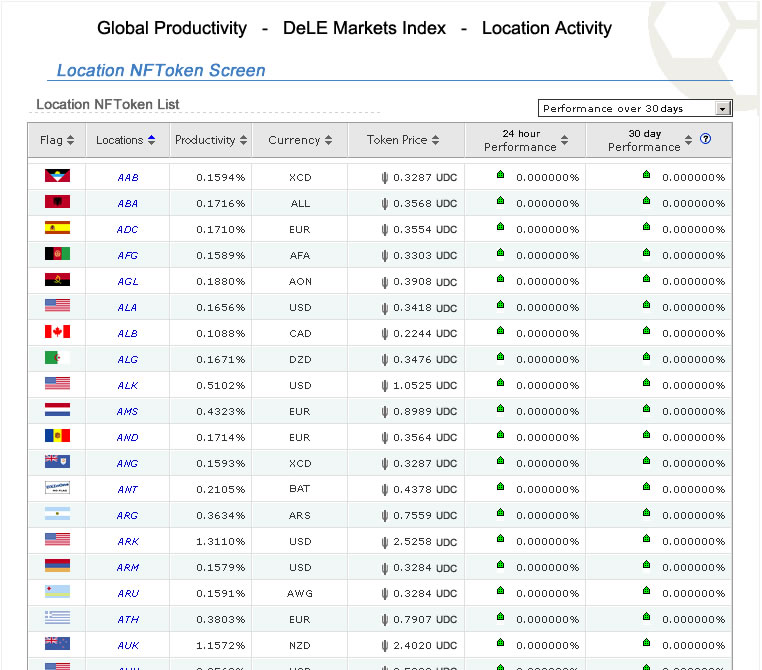
Decentralized Commerce Markets - are designed to scale productivity
The financial markets, centered around selling money as their primary product, aim to facilitate economic wealth for borrowers and profits for lenders through the process of lending and charging interest. However, this system has not effectively increased productivity, and the burden of debt now primarily falls on borrowers.
Although money is created out of thin air for lending purposes, the lack of productive outcomes and the risk of non-repayment persist, prompting lenders to speculate on asset prices and artificially control prices rather than promote productivity. A significant portion of the blame can be attributed to lenders' lack of interest in supporting small and medium-sized enterprises (SMEs) within local economies.
The decentralized local economic market offers a solution by focusing on SMEs, enabling them to achieve full productivity without relying on credit and debt. Instead, SMEs can leverage their vast inventory and its economic value to participate in the market. The decentralized local economic market taps into the economic value of local inventories and distributes this value in micro-values through subliminal advertising, initiating new capital flows validated as universally distributed capital by global aggregate demand (real payments). DeCom Markets fill the void left by the traditional banking system, which primarily focuses on lending to large businesses and only supports small businesses that offer external assets as collateral.
DeCom Markets and Cloudfunding share a productive economic infrastructure similar to the Glass-Steagall Banking Act of 1933, which separated banking for productive purposes from speculative investments. Cloudfunding provides an asset-based architecture for productive purposes, while DeCom Markets offer a non-speculative system that encourages businesses and users to participate without relying on credit and debt as the primary driving mechanism.
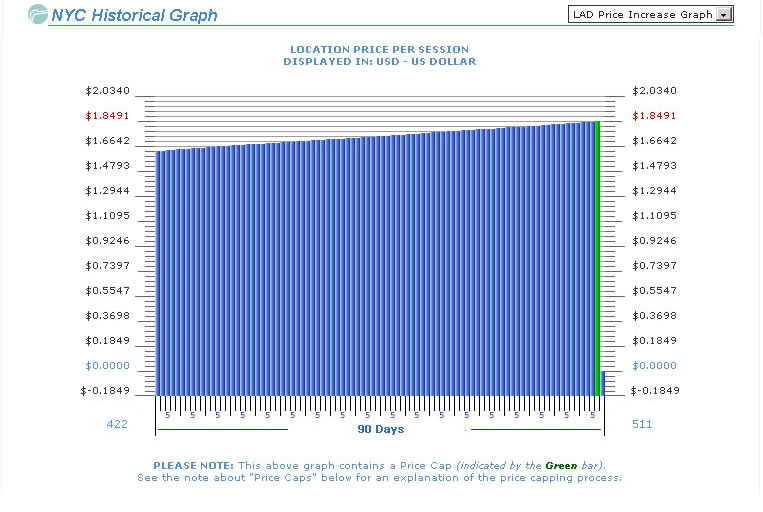
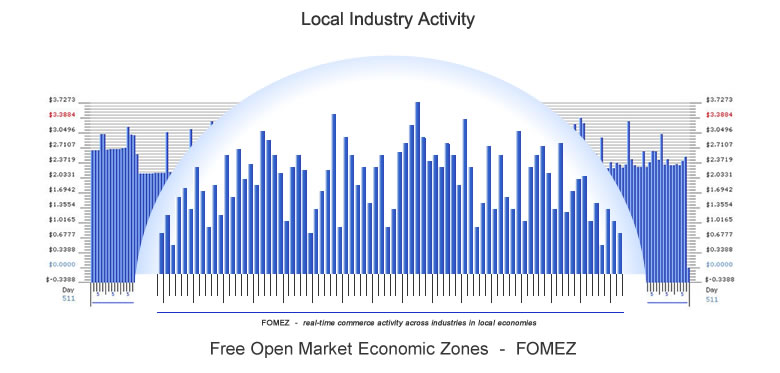
Local economies now have their own 'Gold Standard'
The volume of universal capital is constantly tied and governed by the global volume of productivity in product and service sales across all local economies, known as the Productive Standard. This modern-day Gold Standard utilizes the true economic value of all local economies and a recycling mechanism using global aggregate demand to govern and validate the capital as a neutral, universal economic capital that flows freely between local economies worldwide. This system drives a continuous stimulus into local productivity, similar to the original Gold Standard and the 1944 Bretton Woods System, where the US Dollar was backed by Gold. In this new system, real-time productivity serves as the governing mechanism and intrinsic backing for the neutral universal economic capital.
The economic value is not created out of thin air; it can be found in every shop window, sitting on shelves, and in factories and warehouses as "idle capacity" in local inventory waiting to be sold, representing supply seeking demand. Decentralized local economic markets take these products and services and distribute the full selling prices of each unit in the inventories ready for sale (potential productivity) as free working capital in micro-values to global users through an outsourced selling process using subliminal advertising for exponential distribution.
Through deep tracking and a recycling mechanism, the aggregate demand of global productivity is captured and directed back to fully monetize the new products and services ready for sale, even before they are released to buyers. This process is fully accountable and executed in real-time, without relying on credit and debt.

Designed for exponential scale
Cloudfunding combines various mechanisms, such as advertising and payment processing, which typically operate separately with their own costs, into Automated Selling. This integration allows sellers to fast-track sales with predictability and full selling prices. Even if sellers use traditional paid advertising to gain market exposure, Automated Selling facilitates the bulk of inventory movement without costs for listing, advertising, and payment processing.
DeCom Markets have the grassroots mechanics to automate productivity
Productivity is the primary dynamic through which local economies generate economic wealth by trading products and services from the supply side to the demand side of markets. DeCom Markets disrupt the status quo by shifting productivity from the last step in the financial system's labyrinth of rentier services to a leading catalyst, driving economic wealth and growth directly into local economies through debt-free stimulus. This sustainable stimulus can continue as long as there is supply looking for demand through the outsourced selling of inventories at full selling prices and cascading buying prices that provide buyers with affordability and increased buying power.
The economic value of inventories in local economies is a resource with intrinsic value that can be tracked globally. It is unique because its value cannot be manipulated (such as increasing asset prices) and can be distributed as free working capital across real local economies worldwide. With deep tracking technology, the aggregate demand of global productivity can be captured and, through a recycling mechanism, validated into a neutral, universally decentralized capital. This free working capital can be liquidated into any global currency at local businesses during typical daily sales without interest or costs, or used in peer-to-peer spending.


This Century's assembly lines will scale productivity through outsourced selling
Similar to Henry Ford's re-invention of assembly lines in the early car industry, which had a ripple effect on other industries and transformed how productivity could be expanded with economic benefits flowing to broader communities, decentralized local economic markets could revolutionize industries like Electric Vehicles. So far, the Electric Vehicle industry has experienced limited success in sales, but with the economic infrastructure that DeCom Markets operate on, the industry could experience a moment similar to the assembly line's impact in the early 1900s, resulting in increased productivity.
In the 2020s, with the help of DeCom Markets, the Electric Vehicle industry could be propelled into the fast lane for scaling productivity. The outsourced selling process can monetize and guarantee full profit sales while cascading buying prices give buyers the opportunity to pay prices they are comfortable with. These commercial dynamics can be repeated across businesses and industries, big and small, to generate and sustain ongoing productivity across local economies.

Swimming between the flags
The mechanics between supply and demand have traditionally been seen as exchanging products and services using a third party to facilitate the exchange. However, technology has enabled a more refined interaction between buyers and sellers using the market's economic value of the products and services being exchanged without any third party or value. Technology can track the economic value from when products and services are ready to be sold by the seller to when they are sold and passed from the seller to the buyer, exchanging the full economic value ownership. This collection and distribution of economic value is facilitated through SODA - subliminal organic decentralized advertising, and local Media can partner with DeCom Markets to use SIA - subliminal interactive advertising to boost productivity in local economies.
In recent years, balancing supply and demand for ongoing economic growth has been challenging, with constant seller discounting and low wage growth not keeping pace with price increases. DeCom Markets overcome this by addressing the lack of profitability for sellers and affordability for buyers using technology that separates the supply side of the market from the demand side, allowing economic incentives to be directed at both sides with stimulus. Outsourced Selling maximizes profits for sellers, while Price Demand ensures affordable prices for buyers. Technology enables deep tracking of global products and services activity, allowing economic value to follow the journey from supplier to consumer. This real-time transparency enables direct economic stimulus targeting both sides of the market in local economies, generating more predictable productivity in an infinite loop of activity.
DeCom Markets help rebuild localization, allowing more products to be physically manufactured with local labor rather than relying on outsourcing production to cheaper labor markets, making locally manufactured products uncompetitive. Cloudfunding overcomes this by outsourcing the selling of products (and services), monetizing locally manufactured products with direct foreign digital capital (DFDC) validated from global productivity. DFDC is recycled back through a distribution mechanism to global users who initially helped monetize the inventory, not as loans that need to be paid back. This direct foreign monetization effectively guarantees full selling prices before products and services are released to buyers, who then have Price Demand to compete with and pay prices they can afford, even if the full selling prices are higher than foreign manufactured products. The full monetization from foreign (and local) users is the global scale that the Outsourced Selling mechanism operates in, giving local sellers a competitive advantage over foreign manufactured products by utilizing "foreign labor," digitally. This intrinsic economic value, governed by local products and services, serves as the means of exchange between buyers and sellers while continually "swimming between the flags" within the supply and demand dynamics in a new paradigm.

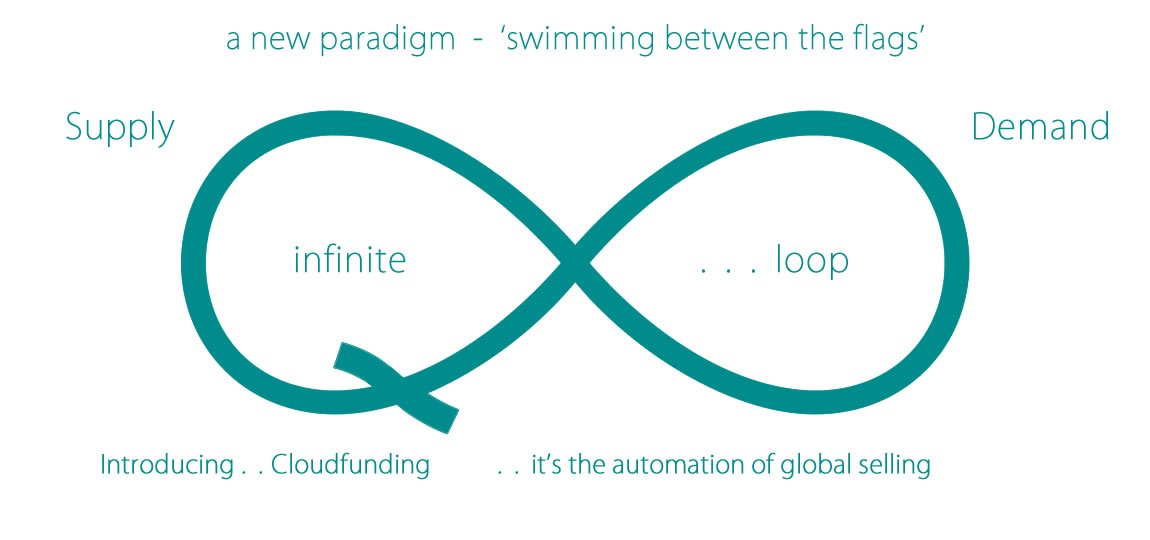
The intrinsic value of products and services in the economic value cannot be diluted or speculated with, making it a modern-day Gold Standard governed by the volume of product and service sales worldwide. The neutral universal trading value is maintained using the aggregate value of global currencies (down to 14 decimal points), providing a stable, universally distributed capital that connects sellers with buyers across local economies without fees, spreads, or local currency transfers. This paradigm shift allows for "swimming between the supply and demand flags" without the need for third-party values.
DeCom Markets offer deleveraging tools and mechanisms for sellers and buyers in local economies to balance supply and demand, reducing reliance on credit and debt, addressing the challenges faced in the recent years with constant seller discounting and low wage growth. As more market makers focus on specific locations to drive productivity, the dynamics change, with a lower share of economic equity available. This dynamic adds a new layer of strategy for market makers to decide whether to increase their involvement in generating productivity in those locations or shift focus to other economies. Liquidating location units allows remaining market makers to benefit from a larger share of economic equity, which they can continue to benefit from as they help drive productivity. This decentralized approach balances trade and payments in real-time at the local level, aligning with the Global Productivity Index.
Retractable market dynamics create a new dimension
DeCom Markets operate on a global scale, directly related to communities and autonomous of the financial system, focusing on SME businesses that generate everyday commercial activity, leading to wages flowing through communities. Local economies are tracked, with profits for sellers and affordable prices for buyers facilitated by real-time interactions and the exchange of economic value between buyers and sellers. The universal economic capital value generated from productivity and governed by its global aggregate demand offers a genuine alternative to creating an international unit of account compared to the creation of credit out of thin air.
Free Open Market Economic Zones (FOMEZs) automatically form as local sellers and buyers trade, taking advantage of the competitive advantage local sellers have in the market. This advantage stems from a shift in the economic infrastructure model at the local level, fully monetizing a seller's products and services before releasing them to local buyers using an economic engine that incentivizes global users to participate. The economic value from completed global productivity validates and governs new capital flows, enabling an infinite loop for inventory listed by local sellers, maintaining full selling prices and maximizing tax revenues.
Local Economic Distribution (LED) Hubs connect sellers in central business zones with buyers in outer suburbs, stimulating trade through incentives that gain velocity in the exchange of economic value, making it profitable and affordable locally. Real-time tracking by the Global Productivity Index helps market makers direct efforts into raising productivity in various local economies, forming new economic alliances between local communities.
DeCom Markets are designed to be pro-active
While the financial markets are structured around the share market as the leading indicator of company efficiency and profitability, it relies wholly on investors channeling money into buying shares in companies in return for dividends as well as share prices that rise - the skill of company strategists, analysts and traders has been refined over the time ( since the East Indian Company was formed ), to convince people to hand over money so the companies can expand and be more productive - that formula and ideology has changed over time and skewed the distribution balance to favor those doing the steering and sharing the spoils.
The economic markets have always been around but never modeled, until now, to represent the productivity of local economies, all the way down to the towns, cities, regions and countries - while every economy is different in size, they can all be treated equally in the new economic markets platform by using an open market democratic formula that allows local markets to expand the number of location units available as market makers see the opportunity to help drive productivity in the specific locations through industries and businesses - it's where the market makers use direct strategies to gain the benefit by getting a greater share of the local economic equity that they helped to generate.
Local activity flows from economy to economy on a global scale
The scale that the Decentralized Local Economic Markets operate in is wider and more directly related to the communities than the way the Financial Markets operate - DeCom Markets has an economic architecture that operates autonomously and independent of the financial system, and has its foundations set in the grassroots environment of Main Street in local economies where SME businesses generate the everyday commercial activity that flows from economy to economy, generating wages that continually flow throughout the communities - at the local level the real time interactions between buyers and sellers are tracked ( not personal surveillance ) as commercial activity, generating profits for the seller in free open market economic zones - FOMEZs - this is the economic activity ( before taxes, wages etc ) recorded in local economies as a Productivity %, which's displayed in real time in the Global Productivity Index ( with thousands more locations to be added ) - from each of these activities there's a location activity tax collected in each local economy that's listed under a Location Token, and this LAT is then equally distributed in real time to the global users who hold the Location units in universally distributed income portfolios - this distribution, which is binary and linear, therefore it can only be positive, maybe zero if there's no activity, but never negative, provides the offset to stagnant wages and price increases while providing the flow-on effect of savings that can be spent into the local economies.
Localization never went away
Local communities, local media and local economies go hand in hand in keeping things ticking along in towns and cities but as globalization threaded its way down into local communities it dissolved much of the local manufacturing and commerce that kept money following within the local economies - so localization needs to be reintroduced but in a way that technology does the hard work - and local Media is still positioned as an important town crier 'connector' in local commerce.
Outsourced Selling supersedes Outsourced Manufacturing
To rebuild localization, where more products are physically built with local labour, instead of relying on outsourcing the manufacturing of products elsewhere using cheaper labour, the major obstacle is obviously the cost of local labour that makes pricing uncompetitive - Cloudfunding overcomes that by outsourcing the selling of products ( and services ), by monetizing the locally manufactured products with direct foreign digital capital - DFDC is the validated aggregate demand from global productivity that's recycled back through a distribution mechanism to the global users, who initially helped to monetize the inventory - this direct foreign monetization ( are not loans that need to be paid back ) effectively guarantees the full selling prices before the products and services are released to buyers, who then have Price Demand to compete with, and pay prices they can afford, even though the full selling prices maybe higher than the foreign manufactured products.
This full monetization from foreign ( and local ) users is the global scale that the Outsourced Selling mechanism operates in - it shifts Productivity from last to be the leading catalyst in Commerce's mechanisms and monetizes it ( Productivity ) so that products and services are 'fully paid for', before they get released to buyers - it flips the global commercial landscape around and gives local sellers the competitive advantage over foreign manufactured products by using 'foreign labour', digitally - utilizing the intrinsic economic value, governed by local products and services, as the means of exchange between buyers and sellers, while continually 'swimming between the flags' within the Supply and Demand dynamics - in a new paradigm - it means that only two components, the Supply side and the Demand side are needed to exchange the economic ( capital ) value between buyers and sellers to complete a trade for products and services, that can be liquidated into local currencies without costs, instead of using a third component offering the use of local currencies with costs - the universal economic capital value generated from productivity, and self governed by its global aggregate demand, is a genuine alternative way to create an international unit of account, compared to the way credit is created out of thin air.
Free Open Market Economic Zones - FOMEZs automatically form as local sellers and buyers trade together, with both taking advantage of the competitive advantage that local sellers have competing for market share - that advantage comes about with a shift in the economic infrastructure model at the local level, one that fully monetizes a seller's products and services before being released to local buyers using an economic engine that incentives global users to participate in 'user friendly' Game Theory and FOMO economics - it's designed to capture the aggregate demand from completed global productivity, and use that economic value to validate and govern the new capital flows ( without incurring debt ) - which's able to exponentially and sustainably monetize an infinite loop for any amount of inventory listed by local sellers - there's a flow-on benefit from maintaining full selling prices, and that's with the full tax revenues that can be gained, instead of it being diluted from seller discounting.
Local Economic Distribution - LED Hubs are a new generation of local economic stimulus that sits between local sellers, who may be located in the central business zones, and buyers who live in outer suburbs, and only occasionally shop in the central city or shopping precincts - it's a local economic hub which can be both a physical B&M or existing businesses connecting sellers with buyers and economies with economies - the inventory held by sellers within most zones has sufficient economic value to exponentially drive an entire local economy on a sustainable path to growth, which can lead to economic flows spilling over into other local regions - it comes down to stimulating trade through incentives that gain velocity in the exchange of economic value, making it profitable and affordable, locally - all of which is tracked in real time by the Global Productivity Index, which helps the market makers direct their efforts into raising productivity in the various local economies - where totally new economic alliances of local economies can be established by local communities.
Local economies can avoid bottlenecks in the supply chain
In post COVID-19, the landscape will undoubtedly be different for those businesses that come through and still have inventory, or can get inventory, it will potentially create an 'off the scale bottleneck' between Supply and Demand - because the consumer will be hesitant in spending what limited reserves, and even credit that will be limited ( not forgetting the generational austerity impact ) - there is a brewing dilemma with an over-supply of inventory looking for a limited demand, which will push businesses into discounting to beat the competition for sales ( even more discounting than pre COVID-19 ).
With the volume of economic value sitting in inventories ready to sell in most local economies being greater than the volume of loans and credit that the financial system can release across local communities, there's a good reason to have a decentralized but independent local economic infrastructure that can avoid the looming bottlenecks between the demand side and the supply side of the markets.


Operating in a new paradigm
The world is realizing that the mechanics of commerce, relying on supply and demand dynamics, are no longer effective in driving productivity. This realization paves the way for a paradigm shift towards a new economic infrastructure that directly drives productivity through localization using the untapped "idle capacity" of inventories waiting to be sold. This untapped capacity is distributed via Subliminal Interactive Advertising (SIA) as free working capital to users in local economies, using the full selling value of inventory as the leading catalyst to govern the flow. The aggregate demand of sold inventory (productivity) validates this flow through a recycling mechanism, directing the value back to monetize newly listed inventories.
This mechanism perpetually stimulates supply and demand markets without finance, forming a new economic alliance of local communities, including local media. This new narrative in how commerce will operate in the digital century has decentralized local economic markets taking over supply and demand activity, distributing economic growth into local economies that are tracked in real-time by the Global Productivity Index.
Unlike the financial markets, which rely on money from the real economy to fund share markets for speculative purposes, DeCom Markets are governed by productivity generated by the demand for supply without speculation. A democratic network of global users driven by incentives creates a vibrant ecosystem of fair open market commerce and trade, independent of the financial system.
Local economies have never had an economic infrastructure independent of the control held by the financial system, mainly due to the complexity of implementing an interconnected system that could move and track commerce and trade between sellers and buyers across economies. The digital age and the internet now provide the means for society to use democratic interactions to gain economic wealth that can be fairly distributed.
Economic value is the true value of the real economy, tapping each local economy's economic value by applying subliminal organic advertising before validating it as a means of exchange. This is a profound difference from the financial system's creation of money to facilitate commerce. In the real economies, the economic value is the new economy's foundational value that cannot be destroyed or diluted, unlike money created for credit, which is destroyed when repaid to balance the lender's books, diluting the local economies of economic wealth when payments and additional interest payments are taken out of the local cashflows.
In the economic markets (DeCom Markets), as the economic value is validated from the free economic value (free working capital) into the neutral universally distributed capital, it cannot be diluted or changed when transferred across the world without costs. This value has one important attribute: it can be tracked from peer to peer down to 14 decimal points in real time for security. This means KYC and AML are paramount in safeguarding the UDC held by each user, including providing secure escrow tools to safely transfer UDC to other parties. Due to the decentralized architecture of the platform, it only needs to track the ownership as the UDC moves between users, without holding or transferring local currencies across borders.
The supply of universally distributed capital held by global users increases organically as more productivity is validated in local economies, and its value remains stable by using the aggregated value of global currencies, maintaining a neutral position as it integrates across supply and demand in local economies. This stability against all global currencies allows asset prices to maintain stability without needing to use inflation while local currencies fight to hold value against other currencies.
As the world confronts the virus crisis and the flow-on debt crisis, DeCom Markets have set a "mark to market pricing" at March 1, 2020, setting the prices of products and services as the true economic value that sellers can operate with. The full selling prices of products and services set from that date are governed by the Global Price Index, tracking the aggregate demand value in each location to determine if any changes in demand (higher or lower) warrant holding or increasing full selling prices. This applies to all products and services, from toothbrushes to clothing, cars, and houses, regardless of market crashes. DeCom Markets operate differently from financial markets, specifically due to the economic architecture that uses productivity's economic value as the leading catalyst instead of credit, keeping both buyers and sellers debt-free when operating on the platform.
This allows sellers, whose businesses are built around the cost of products and services they sell and ongoing operating costs, to continue moving forward with predictable full selling prices. The economic value of products and services from the set date is the established value used to maintain stability in the DeCom Markets, providing local sellers and buyers an operating economic platform with Outsourced Selling and Price Demand to keep commerce flowing, helping all users, buyers, and sellers to deleverage from the debt carried by most businesses and households.
Local media has a seat at the table with SIA, overcoming the saturation and audience ad fatigue that "in-your-face" advertising has been criticized for. SIA operates quietly in the background on mobiles, websites, and medium channels alongside content, with a small logo and a simple Opt-In/Out function, allowing users to automatically hide QwickPic ads while still working in the background. Medium channels like television, web, and video only need to have the QwickPic logo inserted in the corner of a screen or slotted into newspapers to launch SIA (siAds), with viewers and readers spending a few seconds to Opt-In by zooming in to take a snap of the Code. SIA is structured to bring offline and online commerce together on an autonomous economic global platform.
All roads lead back to local economies, with SIA not infringing on traditional TV, print, or radio advertising. On television, it operates during the content time, such as the typical 45 minutes between the 15 minutes of traditional ads shown in every 1 hour of television. SIA is different because once a viewer connects via the siAds logo, as many as 700+ different QwickPic ads can be distributed subliminally in the background during the 45 minutes via the viewers' online device (mobile or laptop) without interrupting content viewing. Newspapers and Radio work similarly with daily Codes (in 24-hour windows) placed in newspapers or spoken over the radio, possibly during news time, with one siAd logo or radio siAd code equivalent to weeks of paid advertising due to the backend connections that readers and listeners have.
The depth of the number of units in the inventories behind the initial QwickPic ads can be 1,000 cars, 10,000 holiday rooms, or 100,000 cinema tickets, even extending to the local dairy industry for farmgate milk prices and retail coffee outlets for millions of cups of coffee or fuel outlets combining to release millions of liters of petrol. Each industry group can use SIA connected via local media to stimulate their local economies, no matter where businesses or consumers are located. All products and services are monetized by the global crowd and governed by the validated aggregate demand of global productivity before being released with Price Demand for users to pay what they can afford.
Local Media has a seat at the table with SIA
Subliminal Interactive Advertising - SIA, overcomes the saturation and audience ad fatigue that 'in your face' advertising has been criticized for - SIA does what it says, it operates quietly in the background on mobiles, websites and medium channels along-side content, with only a small logo and a simple Opt-In / Out function, which gives Users the way to automatically hide QwickPic ads ( majority of ads are ignored anyway ) but still have it working in the background - medium channels like television, web and video only need to have the QwickPic logo inserted in the corner of a screen or slotted into newspapers to launch SIA ( siAds is the service used by mediums and sellers ), and viewers and readers only need to spend a few seconds to Opt-In by zooming in to take a snap of the Code - SIA is structured to bring Offline and Online Commerce together on an autonomous economic global platform.
Nuts and Bolts - all roads lead back to local economies
SIA doesn't need to infringe on traditional TV, print or radio advertising - on television it operates during the content time, such as the typical 45 minutes between the 15 minutes of traditional ads shown in every 1 hour of television - what makes SIA different is that once a viewer connects via the siAds logo, as many as 700 plus different QwickPic ads can be distributed subliminally in the background during the 45 minutes via the viewers Online device of mobile or laptop without interrupting the content viewing.
Newspapers and Radio work similarly with daily Codes ( in 24 hr windows ) being placed in the Newspapers or spoken over the Radio, maybe during news time - with newspapers just one siAd logo or radio siAd code could be equivalent to weeks of paid advertising due to the backend connections that readers and listeners have.
It's not just the 700 plus different products and services but the depth in the number of units in the inventories behind the initial QwickPic ads, which could be 1,000 cars or 10,000 holiday rooms, or 100,000 cinema tickets - it could even be back along the supply chains where viewers could engage with the local dairy industry in a direct market-based solution to help monetize farmgate milk prices, and then get another advantage at the local retail end - even take the coffee industry where a local coffee outlet or a group of coffee houses collaborate to have a million cups of coffee processed and released to the communities, or a single or a group of fuel outlets across several cities combine to release millions of litres of petrol - or having more affordable rents / leases and mortgage payments and utility bill payments processed and released as service deals in the 000s - each industry group can use SIA connected via the local Media to stimulate their local economies, no matter where the businesses or consumers are located - all products and services are monetized by the global crowd and governed by the validated aggregate demand of global productivity, before being released with Price Demand for users to pay what they can afford.


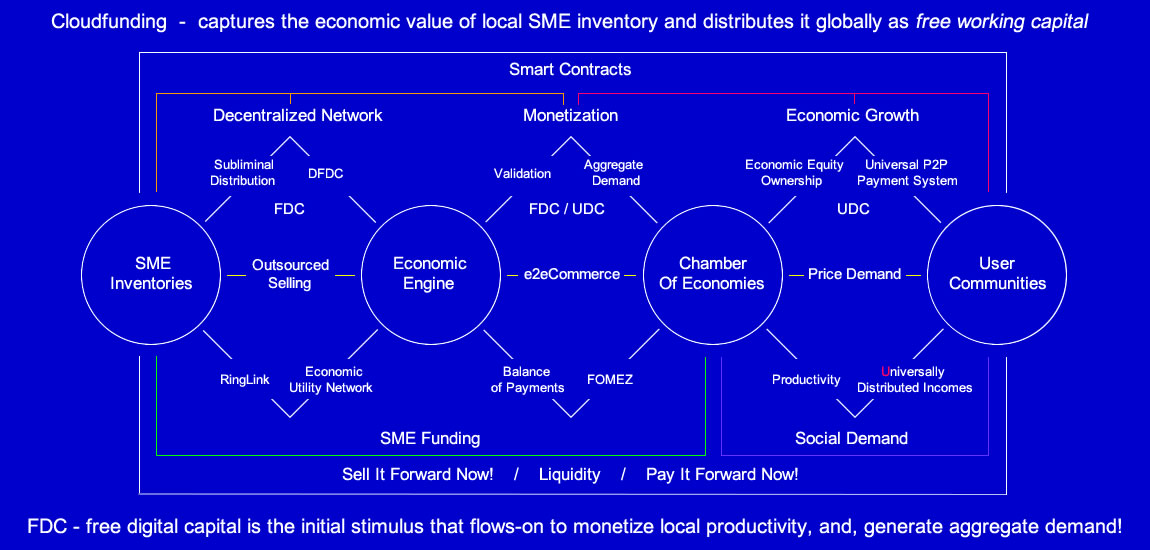
Seller discounting is the most damaging thing in local economies
Seller discounting is a common strategy used when demand is slow, but when a large number of sellers discount, this can send a local economy into long-term decline. By shifting the control of discounting to buyers with Price Demand and giving sellers the chance to outsource the selling, sellers are placed in a stronger position, retaining profits and sustaining productivity.
The financial markets are for speculation, focusing on the price of credit (interest rates) and the quantity of credit (easy or limited). In contrast, economic markets deal with the existing resource of inventories, distributing economic value to global users and communities as free working capital to stimulate the selling and buying of products and services directly, without interest or fees, and no need to pay back.
Decentralized local economic markets have a democratic process that includes any user, from any society, providing access to share economic wealth in their local economy and others without the "cost of entry" enforced by financial markets. These new market makers, acting as traders in the financial system's share market, directly drive productivity in local economies, fully monetizing inventories as decentralized global network members within an autonomous economic market system, avoiding manipulation.
The fundamental difference between financial markets and economic markets is that value is treated differently. Financial markets are centrally controlled, selling future productivity gains and sharing rentier gains among a few, while economic markets use a decentralized design with a democratic architecture that stimulates existing economic value and shares genuine productive gains in real time with many.
The economic market takes a different path by shifting to decentralized competition between markets, making it more beneficial to more people due to more transparency and better balance of economic growth across many local economies, directly affecting Main Street and local communities. This is focused on localization and grassroots communities handling much of the supply and demand markets in local economies.
Main Street now has a sustainable cash flow model, thanks to Cloudfunding, delivering a new era in selling for Main Street. Local sellers have the competitive advantage of technology, getting the benefits of what the Internet promised. Local Economic Distribution (LED) Hubs use Cloudfunding dynamics to increase the velocity of commerce between local sellers and buyers, raising the local economic outlook for everyone. LED Hubs provide a direct action point for increasing productivity output in cities, states, or countries without relying on authorities from above.
LED Hubs sit between local sellers in central business zones and buyers in outer suburbs, providing a path to exponential growth for entire local economies with sufficient economic value to drive local economies on a sustainable path to growth, leading to economic flows into other local regions. Free Open Market Economic Zones (FOMEZs) automatically form as local sellers and buyers trade together, taking advantage of the competitive advantage sellers have when competing for market share, resulting from the shift in the economic infrastructure model at the local level.
Cloudfunding gives local sellers an environment to sell inventory in greater volumes at predictable full selling prices at a faster turnaround rate than traditional selling. Local buyers have more incentives to buy with Price Demand, allowing buyers to pay prices they want to pay. For sellers of pizzas to fashion to cars, sales volume can exponentially increase and be sustained with real-time reconciliation, avoiding the need for credit terms. Cloudfunding integrates a free peer-to-peer exchange of local fiat currencies with a neutral internationally tracked trading unit of account to securely exchange the ownership of products and services in real-time without holding or transferring local currencies across borders.
Cloudfunding breaks down financial inclusion barriers by decentralizing control over capital flows across economies using a global consensus. Cloudfunding gives the overall community the means of being proactive within their local economy and gaining a direct benefit without waiting. Instead of shareholders benefiting from dividends from a company's profits before employees, Cloudfunding breaks down the hierarchy in the economic model, giving individual users the means of gaining financially from various local companies selling products and services within an economy via Outsourced Selling, Price Demand, and UDI portfolios.
The digital cash economy is ubiquitous across local economies, with a simplified process from the seller listing the inventory to the buyer's payment, breaking the complicated processes inflicted by early adoption of credit and debit cards in online commerce. Cloudfunding brings free online cash commerce into the mainstream by digitizing traditional cash payments, similar to traditional cash exchanges without fees. No more costly cards or interest payments; just simple, ubiquitous free payments from a mobile, with high-end security and tracking, addressing the Achilles' heel of card providers' process.
The paradigm shift comes in reversing how incumbents have extracted local capital flows from local economies by centralizing control of the money supply via credit and debt. Cloudfunding decentralizes this control, keeping capital flowing within local economies and increasing it with Direct Foreign Decentralized Capital from other local economies worldwide. This is where the local Chamber of Economies comes to the fore as part of the Global Chamber of Economies, where productivity trends can be tracked.




One day turn-around
The era of receiving stock and selling overnight will become the new norm for sellers adapting to the new frontier in retailing with Outsourced Selling and Price Demand. Sellers will only need to focus on restocking supplies and customer service, allowing autonomous selling or engaging with sales from their own Digital Sales Division.
LED Hubs enable sellers to store and deliver inventory midway between themselves and local buyers, connecting the Offline to Online (O2O) worlds. Cloudfunding's backend economics disrupt the traditional parity between asking and paying prices between buyers and sellers by separating Supply from Demand, removing barriers to scale indefinitely in the "sell high, buy low" economy. LED Hubs operate with a free, neutral O2O mechanism between Supply and Demand, making it ubiquitous across all market sectors.
LED Hubs stimulate local economies by distributing Cloud Capital or free working capital into the hands of global users. This working capital is spent on strategies by the Global Crowd, directing value from around the world to fully monetize seller inventories for free, using Direct Foreign Decentralized Capital (DFDC). DFDC utilizes a unique global tracking system that can transfer value from one economy to another without holding or transferring any local currencies, driving a new linear business model into local economies without incurring debt.
Both Offline and Online worlds have different mechanics and limitations that need to be absorbed into their operating costs. LED - Local Economic Distribution Hubs are designed to merge these worlds into seamless O2O Commerce.
Direct Market productivity
Every User can get involved in the productivity side that can influence trade by being an OMM - Open Market Maker - OMM's are market makers that passively participate in driving trade for the Sellers through to the eventual Buyers - Direct Market provides direct access to local economic growth from the Productivity for Users to benefit from their local businesses with the sales they make with other local and global Buyers
- plus as an OMM you're a business entity that doesn't handle any stock or deal with any customers, it's the simple process of using Cloud Capital / FEV / Cloudfunds that are earned for free, and using them to set strategies, then add a bid or be eliminated when it's needed - winning deals earn a profit margin for the OMMs that most businesses could never achieve but one of the main outcomes of the Game Theory bidding process is to validate Cloudfunds into Universally Decentralized Capital using a decentralized and democratic global system.
Every user can participate in the productivity side and influence trade by becoming an OMM (Open Market Maker). OMMs are market makers who passively participate in driving trade for Sellers to eventual Buyers in the Direct Market, providing direct access to local economic growth from productivity. Users can benefit from their local businesses with sales they make with other local and global Buyers.
As an OMM, you are a business entity that doesn't handle stock or deal with customers. Instead, you engage in the simple process of using Cloud Capital, Free Digital Capital or Cloudfunds, which are earned for free, to set strategies and add bids or be eliminated when needed. Winning deals earn profit margins for OMMs that most businesses could never achieve. One of the main outcomes of the Game Theory bidding process is to validate FDC / Cloudfunds into Universally Decentralized Capital using a decentralized and democratic global system.
-
-
-
-
-
-
-
-
-
-
-
-

Cloudfunding merges in-store showrooming with real-time Online Demand
Cloudfunding and LED Hubs empower local sellers to invite buyers to visit their in-store locations, similar to showrooming where buyers check in-store prices before going online and potentially purchasing elsewhere. Now, with real-time Price Demand, local sellers have a competitive advantage with predictable and guaranteed sales without the need for intrusive targeted advertising and discounting.
Cloudfunding uses Subliminal Organically Decentralized Advertising to distribute the full market value of each product and service globally at no cost to sellers or buyers. Whether it's a takeaway pizza, shoes, hotel room, taxi fare, car, or even a house, Cloudfunding provides sellers with the freedom to control how they sell at guaranteed full selling prices, while buyers control what price they want to pay with Price Demand. The Global Price Index (GPI) determines price increases or decreases based on market analysis.
Cloudfunding offers a new experience for buyers and sellers with P2P payments using Universally Decentralized Capital. The interaction begins between buyers and sellers using cash, with sellers listing the amount they want to liquidate in their Business Console and exchanging Universally Decentralized Capital (UDC) for local cash with local buyers wanting to fund their accounts or exchange at another store or at a LED Hub.
Cloudfunding positively affects economies, taking advantage of economies of scale to expand the validation of Universally Decentralized Capital virally.
The change in how capital flows from economy to economy with Cloudfunding opens up new ways for businesses and entrepreneurs to gain backing for their ventures or expansions. Free Direct Backing (FDB) offers free, direct backing without having to put up equity or pay back loans or interest. FDB is linked directly to Direct Foreign Decentralized Capital (DFDC), where anyone can directly back a worthwhile venture with a direct benefit in increasing productivity.

Cloudfunding operates all along the Supply Chain
Supply chains in B2B and B2C markets are streamlined to surpass CRM, banking, and fintech enterprises and third-party incumbents by leveraging RingLink technology and e2eCommerce. This process begins with sellers listing their inventory through Outsourced Selling and setting a time to release deals to local buyers, leaving Price Demand to handle the final sales.
Cloudfunding addresses the increasing issue of predatory pricing and actions by third-party incumbents that construct digital walls to limit fair competitiveness between sellers. Cloudfunding utilizes Subliminal Organically Decentralized Advertising, a free service distributing a seller's inventory exposure on a global scale.
Cloudfunding serves as the economic infrastructure that levels the playing field in all markets for both Offline and Online Commerce, bringing a scalable and sustainable New Economy to local economies by providing affordable products and services to local buyers.
Having more affordable prices for products is not complete without offering free transport and delivery costs. A new Freight and Delivery Service industry platform called FreDel Tech introduces a new perspective to an industry that moves economic value between sellers and buyers.
Supply chain industries, such as the dairy industry, can move Farmgate milk through the entire supply chain from farm to processors to retail to the consumer using Cloudfunding. At each stage along the supply line, bargaining power is equally balanced, with farmers receiving higher farmgate prices (set to local production costs with profits and linked to scale as global prices rise) while processors and retailers compete daily for product on the Domestic Open Market Xchange Trading Platform (DOMIndex).



The simple steps to using LED Hubs
Regional sellers list inventory to Outsourced Selling, adding free home delivery from their store or to pickup at a nearby LED Hub.
Inventory can be delivered by sellers to the LED Hubs using free delivery, ready for pickup by Online buyers.
Buyers can see the products in-store and go Online to buy either with delivery from the store or pickup from a nearby LED Hub.
Each LED Hub is established with its own unique Location Token - the productivity between sellers and buyers flowing through its operations is tracked as part of the Global Chamber of Economies.
There are several levels that users can be involved with in establishing LED Hubs that can be local or even somewhere else - teams and Co-Operatives can be established to earn from the local economy by being pro-active as part of the Global Crowd that drives the Outsourced Selling of products and services in the various economies.




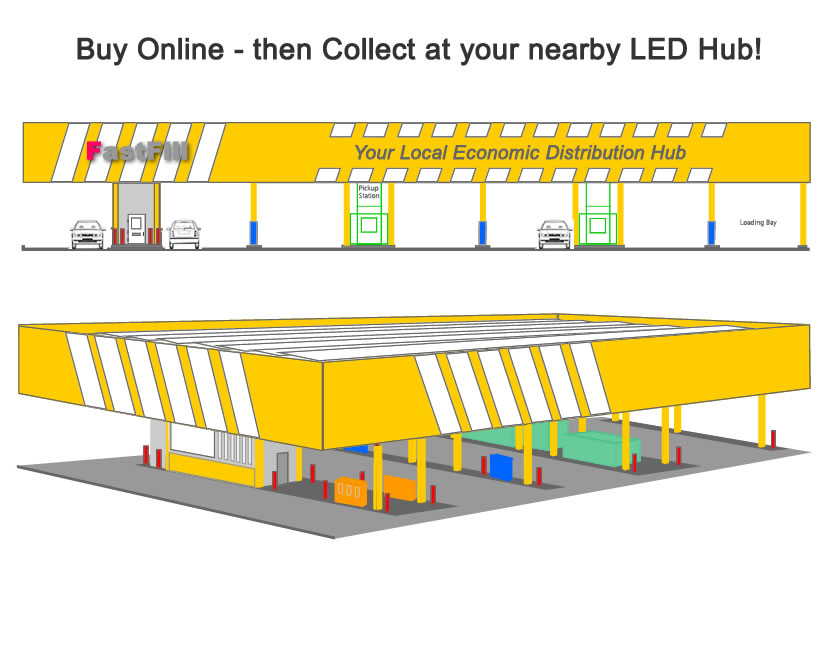
LED Hubs solve the 'last mile delivery' for Sellers
Local sellers list the inventory they want to sell, and decide if the pickup will be at their store or at LED Hubs - there're no storage or selling costs, even delivery from store to LED Hubs or home delivered is free within FOMEZs, it's more about convenience for buyers.
Unlike traditional commerce that operates mostly on credit and terms, LED Hubs operate only on cash terms - as deals are sold with Price Demand, payments are released directly to seller accounts - achieving a much faster turnover of stock and cashflow.
Collaboration between local sellers can continually influence local markets and economies via a higher velocity in trading products and services at full margins - streamlining the flow between supply and demand that's debt free with real-time sales and payments.
Local sellers can join others across various industries in directly establishing Local Economic Distribution Hubs and get direct ROI from sales moving through the local economy - LED Hubs merge local productivity seamlessly across the Global Chamber of Economies.
Local business ventures can now get Free Direct Backing
As with all businesses, there are times when expansion to grow is essential - Free Direct Backing can be used by local businesses to get the support they need to expand their business from a global crowd.
While Cloudfunding helps sellers to outsource the selling of their products, LED Hubs solve the 'last mile delivery' - Free Direct Backing offers businesses with a way to get backing for their business expansion without needing collateral or giving up equity.
To help sellers track all their product movements and sales, the Digital Sales Division - DSD is available to build out the business into the New Digital Economy.
Contact
Privacy Policy
Terms of Service